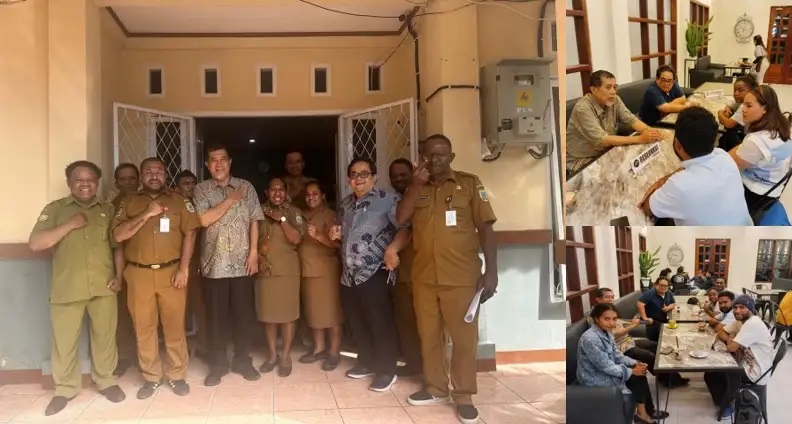News
BRIN Studies Potential Leading Products of Central Papua
WINDONESIA October 1, 2024 (National Research and Innovation Agency)
(National Research and Innovation Agency)
The National Research and Innovation Agency (BRIN) had the opportunity to visit (23-25/09) the Central Papua Province Regional Development Planning, Research, and Development Agency (Bapperida) in Sep. 23-25, 2024. They were welcomed by Central Papua Bapperida Head Jull Edy Way and the Bapperida management team.
The visit, led by BRIN Regional Research and Innovation (RID) Deputy's Papua Regional Coordinator Raden Agus Sampurna and accompanied by Malikuz Zahar is part of BRIN's efforts to strengthen coordination and technical guidance with the Central Papua Province Regional Research and Innovation Agency (BRIDA).
At the same time, the visit is done to explore the main problems in and potential leading products from Central Papua Province. Coffee is one of Central Papua's potential leading products, which is cultivated across various regencies such as Dogiyai, Paniai, and Mimika.
In the discussion, Jull raised important issues related to increasing the added value of local commodities, especially coffee and horticultural products. One of the main obstacles faced is the high cost of transportation between regions, which limits the distribution of said products.
"As a result, many coffee and horticultural products are only marketed in the local market. Meanwhile, marketing outside the region is highly dependent on large traders," he stated in Nabire Regency, Central Papua on Sep. 25, 2024.
Jull added that to it is impossible to burden farmers alone with quality assurance and sustainable production. He said there must be support from the government until farmers become independent from their farming activities, with coffee only able to be harvested after three years of planting.
"Currently, [the Central Papua] Bapperida is mapping the coffee production potential of every regency [in the province], as well as identifying the problems faced by farmers. In the near future, [the Central Papua] Bapperida will also initiate a coffee festival as an effort to introduce local coffee from Central Papua to a wider market," he explained.
Jull elaborated that the festival is expected to empower local coffee business actors and increase the exposure of Central Papua coffee products both in the national and international markets.
"In addition to coffee, Central Papua also has great potential in the horticulture sector. However, horticultural products are currently still limited to local traditional markets. Many horticultural products that are not bought by the local market end up rotting or becoming animal feed," he revealed.
Jull hopes for support and cooperation with BRIN in conducting studies on strategic issues and developing the region's potential leading products. In addition, he also wants there to be a study on how to increase Central Papua's locally-generated revenue (PAD), which currently relies heavily on central government assistance.
Meanwhile, Agus stated that BRIN emphasized the importance of registering geographical indications for coffee and other local commodities.
"This is important to strengthen the branding of these products in the eyes of national and international consumers. With geographical indications, the reputation and quality of products that are unique due to geographical factors can be better maintained and widely recognized," he explained.
BRIN also had the opportunity to meet with Papua Youth Creative Hub (PYCH) Central Papua Province Micro, Small, and Medium Enterprises (MSMEs) Coordinator Simson Dasnarebo. Simson explained that PYCH was formed to provide guidance to talented young Papuans to develop their abilities and resources in various fields, including entrepreneurship.
"PYCH Central Papua is actively providing guidance to business actors in the fields of animal husbandry, fish farming and commercial fishing, as well as agriculture. Some of the problems faced by MSMEs in Central Papua are limited access to marketing, infrastructure, technology, and limited ability to scale up business capacity. There are many cases of businesses that have difficulty developing, including those selling Nabire oranges, sago, coffee, and other commodities," he divulged.
Agus suggested for collaboration with both central and regional governments, including at the provincial and district levels. In addition to actively producing inventions and disseminating technology, BRIN also provides technical guidance to BRIDA or Bapperida.
"It is hoped that the existence of PYCH can become a research and innovation ecosystem in the regions coordinated by BRIDA or BAPPERIDA. PYCH can be the spearhead in strengthening MSMEs through young entrepreneur development activities based on regional excellence," Agus said .
Meanwhile, the BRIN Team was received by the Central Papua Bappeda Control Department Head Palilu Tangke in their visit to Mimika Regency. He said that the process of forming a Bapperida is still in process of awaiting a new leader.
"The problems in Mimika Regency include stunting and poverty, which are still quite high. The issue of providing clean water for drinking in several districts requires BRIN support. [Another issue is the] provision of electricity for areas that have not been reached by the electricity network by utilizing river flow," he said.
Palilu also revealed that the leading potential products of Mimika Regency are coffee, snapper fish bubbles, gele, mangrove crab, red fruit, and Komoro carving motifs.
"We need BRIN's support to increase their added value. The Mimika Regency Bappeda will initiate the registration of intellectual property for Komoro motif sizes," he added.
In the discussion, Agus introduced communal intellectual property that includes traditional cultural expressions which are appropriate for traditional designs belonging to the Komoro indigenous community.
"Including the importance of intellectual property protection in order to provide exclusive rights that assists the commercialization of culture for business actors who come from the indigenous community," Agus concluded .
Furthermore, the BRIN team visited and had a discussion with the indigenous people who crafted Komoro carvings. Komoro carvings have been introduced to local and international consumers since 1981, including to several European countries.

